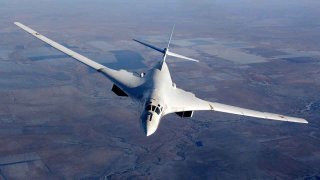Russia’s Tu-160M “White Swan” Bomber Is A Cold-Blooded Killer
Last February, images of Russian President Vladimir Putin sitting in the pilot’s seat of a Russian Tupolev Tu-160M long-range strategic bomber have gone viral across Russian social media. Putin was celebrating the fact that the legendary Soviet-era United Aircraft Corporation’s Tupolev Design Bureau was significantly upgrading its iconic “White Swan” bomber. Just a few weeks ago, the Russian Aerospace Forces received the first tranche of these upgraded birds.
As the Ukraine War progresses and Russia’s strategic situation becomes more tenuous in the face of Western resistance, the Russian military has embraced a rapid modernization program that is nothing short of stunning (especially considering the, frankly, ridiculous claims from Western media sources that sanctions would break the back of Russia’s economy and defense industrial base).
Equipped with new NK-32-02 engines, with a reported maximum speed of over Mach 2.05, the swept-wing long-range strategic bomber has an entirely new lease on its storied life. Tupolev retained the variable-sweep wing design that its predecessor sported, allowing for the bird to adapt to subsonic or supersonic speeds. What’s more, the combination of its original variable-sweep wing design coupled with its NK-32-02 engines, the Tu-160M White Swans now have a wildly extended strike range and maneuverability, as well as an impressive speed.
Understanding The Tu-160M
In terms of her armaments, the Tu-160M is a highly formidable warbird, carrying up to twelve cruise missiles, including the nuclear-capable Kh-55 series and the newer Kh-101 and Kh-102 long-range air-launched cruise missiles. Each of these classes of cruise missiles has been modernized to incorporate enhanced stealth features, such as reduced radar cross-sections, allowing for these weapons to penetrate enemy air defense systems more reliably. Its progenitor was nuclear-capable, and Tupolev ensured that the Tu-160M had a versatile weapon capacity, meaning these birds could fly with both conventional and nuclear weapons in her bomb bays.
Advanced cruise missiles and gravity bombs allow for missions that are variegated and equally lethal to Russia’s enemies.
Tupolev’s advances for the Tu-160M involve multiple mechanical upgrades. More importantly, though, Tupolev has bettered the bird’s avionics, navigation, and electronic warfare (EW) systems. The aircraft now features a glass cockpit and unique technological accouterments, such as the Novella NV1.70 radar system as well as anti-jamming equipment, providing pilots with an insane amount of situational awareness and a greater ability to penetrate enemy air defenses to deliver killing blows with their robust onboard ordnance.
The Tu-160M’s role in Russia’s nuclear triad (which includes submarine-launched ballistic missiles and land-based intercontinental ballistic missiles, ICBMs) is pivotal. The White Swan’s ability to launch a variety of weapons at standoff distances makes this bird a key element in Russia’s nuclear deterrence. It was a smart move by Moscow to authorize the modernization program that Tupolev wanted for their Tu-160s.
The History of the Tu-160M
These birds can be traced all the way back to the heady days of the Cold War. When Soviet Russia collapsed, so too did the power of the Soviet military machine. The successor government of the Russian Federation tried to maintain as much of that legendary military prowess as possible.
Still, the Tu-160’s production line was halted in 1992 as a direct result of the USSR’s implosion. Moscow eventually restarted production on the birds in 2015, unveiling the Tu-160M (which ultimately flew in January 2022).
A Significant Challenger For The U.S.
Tu-160Ms have been showcased across multiple Russian areas of operation, most notably in the Arctic, a region that Moscow has highlighted as their most strategically significant zone since 2008. Indeed, when I briefed the Air Force intelligence team three years ago at Joint Base McChord, I was informed of intercepts involving the Tu-160 off the coast of Alaska, marking a significant escalation by Russia in the Arctic.
Washington has erred significantly in antagonizing the post-Soviet regime in Russia. We were told that the Russians did not matter anymore geopolitically and that they could easily be ignored and pushed around.
Indeed, this assumption formed the basis of U.S. foreign policy in Eurasia for the last thirty years. The evolution of the mighty Tu-160M is but one more example of how wrong those assumptions were—and how Americans today have been made less safe because of it.
Brandon J. Weichert, a Senior National Security Editor at The National Interest as well as a Senior Fellow at the Center for the National Interest and a contributor at Popular Mechanics, consults regularly with various government institutions and private organizations on geopolitical issues. Weichert’s writings have appeared in multiple publications, including the Washington Times, National Review, The American Spectator, MSN, the Asia Times, and countless others. His books include Winning Space: How America Remains a Superpower, Biohacked: China’s Race to Control Life, and The Shadow War: Iran’s Quest for Supremacy. His newest book, A Disaster of Our Own Making: How the West Lost Ukraine, is available for purchase wherever books are sold. He can be followed via Twitter @WeTheBrandon.
Image: FastTailWind / Shutterstock.com.

